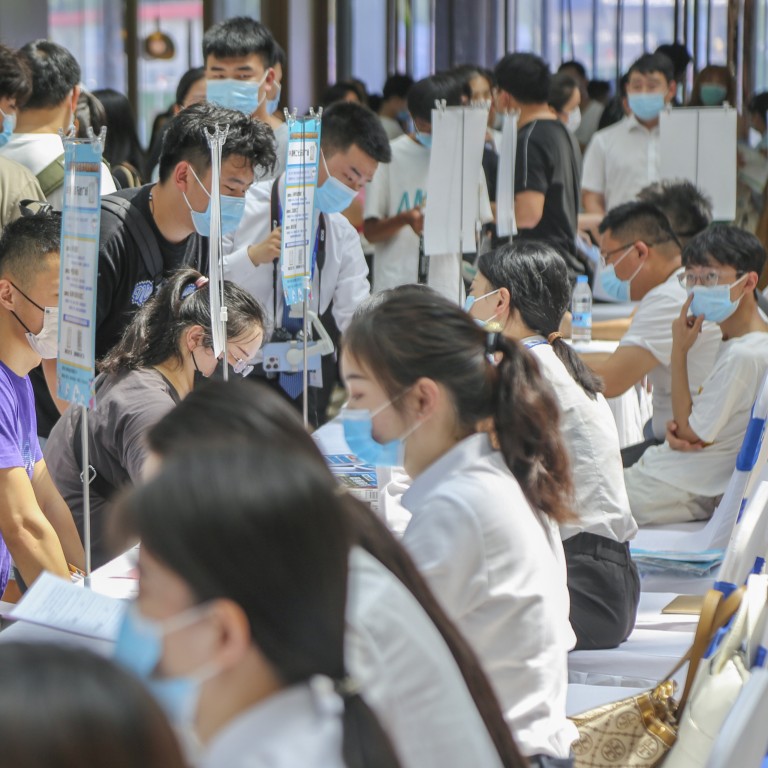
Explainer | What is China’s youth unemployment rate, which hit a record high in April, and why does it cover ages 16 to 24?
- The unemployment rate for the 16-24 age group in China hit a record high of 20.4 per cent in April, after rising from 19.6 per cent in March
- Rising youth joblessness is one of Beijing’s biggest headaches, threatening the top leadership’s bottom line of ensuring social stability
What is China’s youth unemployment rate?
China’s youth unemployment rate refers to the percentage of unemployed people who are between the ages of 16 and 24 with the “ability” and “willingness” to work.
It is a key indicator for Beijing to gauge social stability and economic growth.
It mainly covers recent graduates from high schools or vocational schools, who are aged between 15-18, and college students, who often graduate at the age of around 22.
China’s nine-year compulsory education enables students over six years old nationwide to have free education at both primary school and junior secondary school, but senior secondary school and college education are not compulsory.
Recent graduates often find it difficult to find employment due to their lack of experience, specialised skills and qualifications.
Is youth unemployment in China a new problem?
China began announcing a youth unemployment rate in 2018, and in January 2018, it stood at 11.2 per cent.
China’s youth unemployment rate tends to increase leading up to July, when high school and college students graduate.
Chinese cities offer young talent free housing as jobless rate soars
How does China’s youth unemployment rate compare to elsewhere?
China’s youth unemployment rate is relatively high compared to most other major economies and some emerging markets.
Youth unemployment in the United States - defined as those aged between 15 and 24 without work but available for and seeking employment – averaged 8.1 per cent in 2022, down from 9.57 per cent in 2021 and 14.85 per cent in 2020.
The youth unemployment rate in the US decreased to 6.5 per cent in April, which was the lowest since 1953, down from 7.5 per cent in March having hit 27.4 per cent in April 2020.
Hong Kong, Germany, South Korea and Japan all reported a youth unemployment rate of below 7 per cent in their recent figures.
Hong Kong’s youth unemployment rate decreased to 5.4 per cent in March from 5.8 per cent in February, while Germany’s figure also declined from 5.7 per cent to 5.6 per cent during the same period.
South Korea’s rate also fell to 6.5 per cent in April from 7.2 per cent in March, while in Japan, 4.7 per cent of its youth were unemployed in March, down from 5.2 per cent in February.
Taiwan’s youth unemployment rate remained steady at 11.8 per cent in February and March, while the figure is less than 8 per cent in both Vietnam and Thailand.
As ‘weak confidence remains’, nearly 20 per cent of China’s youth jobless
At the other end of the scale, youth unemployment in Turkey stood at 20.1 per cent in March and 21.6 per cent in Sweden.
In Italy in March, 22.3 per cent were unemployed, while in Greece, the figure stood at 24.2 per cent.
In Spain, the figure has remained above 29 per cent since November, having fallen from a recent high of 31.6 per cent in both August and September.
Why is the youth unemployment rate in China rising?
Youth unemployment rates are usually two to three times higher than for adults over 25, according to the International Labour Organization.
In April, China’s overall urban surveyed jobless rate stood at 5.2 per cent, while the figure for the 25 to 59 age group stood at 4.2 per cent.
The number of university students in China has seen a remarkable tenfold increase from two decades earlier, while Beijing’s zero-Covid policy over the last three years has left small- and medium-sized enterprises struggling.
Investor confidence also remains low despite China’s reopening at the end of last year.
Government officials in China have also blamed discrimination against blue-collar occupations for the imbalance in employment, with many factories struggling for workers.
What is the outlook for youth unemployment in China?
Unemployment is set to remain a lingering problem in China due to the record number of graduates set to enter the job market this year.
Zhang Zhiwei, chief economist at Pinpoint Asset Management, referred to the youth unemployment rate in China rising above 20 per cent in April as a “worrying sign”.
Beijing has promised to provide hiring subsidies, create more vacancies in the public sector and within state firms, while also offering 1 million internship opportunities.
But while China’s economy is projected to grow by 5 per cent this year, many entrepreneurs still remain uncertain due to the disruptions caused by the pandemic.
The National Development and Reform Commission, the country’s top economic planning agency, said after the release of the April unemployment data in mid-May that it will concentrate on providing vocational skills training to young people to equip them with the skills necessary to meet the needs of the unbalanced job market.


